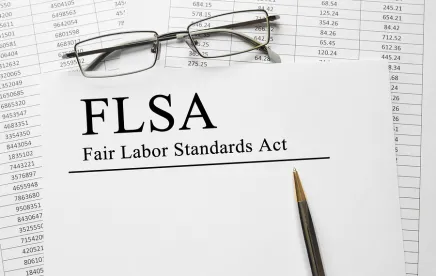In a decision of considerable significance in the world of wage and hour litigation, the United States Court of Appeals for the Fifth Circuit significantly departed from conventional standards for assessing conditional certification under Section 216(b) of the Fair Labor Standards Act (“FLSA”). In Swales v. KLLM Transport Services, Inc., the Fifth Circuit rejected the conditional certification process entirely and drastically altered the procedure for assessing whether potential members of a collective action under the FLSA are “similarly situated.”
Background
Plaintiffs, a group of truck drivers who drove for defendant KLLM Transport Services, brought a FLSA collective action alleging they were misclassified as independent contractors. Upon the Plaintiffs’ motion for conditional certification, the district court applied the generally accepted two-step Lusardi test for certifying a collective and granted the motion.
Section 216(b) of the FLSA provides that employees may proceed as a collective action when they are “similarly situated,” but does not further define this term. As such, courts have adopted the “conditional certification” process as a method for determining whether plaintiffs and other employees are sufficiently similarly situated. After a court grants conditional certification, written notice may be sent to other employees, who can then join the lawsuit by “opting in” to the collective. Most federal courts have adopted this approach, which derives from a 1987 New Jersey district court opinion, Lusardi v. Xerox Corporation.
Under step one of the Lusardi test, the district court decides if proposed members of a collective are similar enough to receive notice of the pending action. This determination is usually based on the pleadings and affidavits of the parties, and often requires no more than allegations that the collective members were victims of a single decision, policy, or plan. The standard for this first stage of conditional certification is minimal and often perfunctory. See, e.g., In re JPMorgan Chase & Co., 916 F.3d 494, 501 (5th Cir. 2019) (the standard for satisfying step one is “fairly lenient” and based on “minimal evidence”). In rare cases, aggressive defendants are sometimes able to overcome this low standard, but many courts rubber stamp first-step conditional certification motions. See, e.g., Dimery v. Univ. Prot. Serv., LLC, Case No. 6:15-cv-2064 (Mar. 24, 2016) (rejecting conditional certification under FLSA); Kraft v. Gongos, Inc., 2019 WL 1594046 (E.D. Mich. April 14, 2019) (same).
During step two, at the conclusion of discovery, the court makes a final determination about whether the plaintiffs and the opt-ins are similarly situated with the benefit of full discovery and under a stricter standard. Courts consider: (1) the disparate factual and employment settings of the individual plaintiffs; (2) the various defenses available to the defendant which appear to be individual to each plaintiff; and (3) fairness and procedural considerations.
A minority approach to determining whether opt-in plaintiffs are similarly situated requires the plaintiffs to satisfy all requirements of Rule 23 class certification, insofar as those requirements are consistent with the FLSA. However, numerous courts have pointed out flaws with both the majority and minority approaches. See, e.g., Campbell v. City of Los Angeles, 903 F.3d 1090, 1111-16 (9th Cir. 2018) (collecting cases).
The district court’s opinion in Swales, based on a modified version of the Lusardi test to account for the parties’ limited discovery, certified the issue of collective action certification under the FLSA for interlocutory appeal and stayed the case on its own motion. The district court reasoned there were “open questions regarding the applicable standards [of conditional certification], especially when some discovery has occurred.” The Fifth Circuit granted the petition for review.
Reasoning
In its opinion, the Fifth Circuit squarely rejected the Lusardi test, reasoning it frustrates the notice process, provides little guidance due to its amorphous, ad hoc nature, and strays from the text of the FLSA. On this last point, the court noted the statute says nothing about conditional certification and cannot be read to support any certification test. Rather, the law requires the district court to ensure notice goes out to those who are “similarly situated” and to make such a determination by “scrupulously avoid[ing] endorsing the merits of the case.” The result of the conditional certification process, the Fifth Circuit reasoned, was that courts were forced to unjustifiably defer threshold questions weighing directly on whether opt-in plaintiffs were similarly situated because they were intertwined with the merits of the case.
The Fifth Circuit then held the proper procedure required a district court to identify, at the outset of the case, what facts and legal considerations will be material to determining whether a group of employees is similarly situated. The district court then must determine whether and to whom notice should be issued by considering all of the evidence made available based on the discovery it deemed necessary. Under this standard, courts have the option to conclude whether the plaintiffs are similarly situated, to assess whether the plaintiffs are too diverse to be considered similarly situated, to determine whether they have failed to meet their burden of establishing similarity, and/or to decide that certain subsets of the proposed opt-in collective are similarly situated.
As such, the Fifth Circuit vacated the district court order granting conditional certification and remanded for further proceedings consistent with the new framework.
Takeaways
The Swales decision has potentially drastic implications for FLSA cases within the Fifth Circuit, as it explicitly eliminates the conditional certification process under 216(b), replacing it with immediate discovery and decision-making into the merits of a claim to determine if opt-in plaintiffs are similarly situated. It appears courts in the Firth Circuit will no longer “rubber stamp” conditional certification based on mere affidavits. The decision likewise grants a great degree of discretion to district court judges to tailor discovery and make prompt, final decisions with respect to the viability of a collective action. The Swales decision will lend itself to more aggressive defense tactics when plaintiffs move for conditional certification under the FLSA. The Fifth Circuit’s departure from the Lusardi test could likewise have impact on the numerous appellate circuits that have yet to reject or endorse Lusardi.



 />i
/>i
